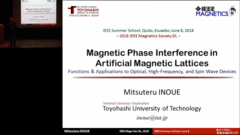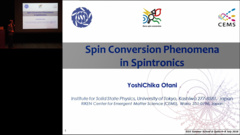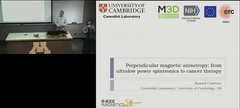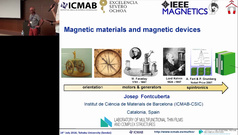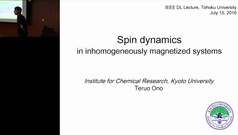Nanoscale Magnetism with Picosecond Time Resolution and High Sensitivity - Hendrik Ohldag - IEEE Magnetics Distinguished Lecture
This is a recording of from the IEEE Magnetics Society, featuring distinguished lecturer Hendrik Ohldag, giving his presentation, "Ultrafast and Very Small: Discover Nanoscale Magnetism With Picosecond Time Resolution Using X-Rays."
Full abstract:
Today's magnetic device technology is based on complex magnetic alloys or multilayers that are patterned at the nanoscale and operate at gigahertz frequencies. To better understand the behavior of such devices one needs an experimental approach that is capable of detecting magnetization with nanometer and picosecond sensitivity. In addition, since devices contain different magnetic elements, a technique is needed that provides element-specific information about not only ferromagnetic but antiferromagnetic materials as well. Synchrotron based X-ray microscopy provides exactly these capabilities because a synchrotron produces tunable and fully polarized X-rays with energies between several tens of electron volts up to tens of kiloelectron volts. The interaction of tunable X-rays with matter is element-specific, allowing us to separately address different elements in a device. The polarization dependence or dichroism of the X-ray interaction provides a path to measure a ferromagnetic moment and its orientation or determine the orientation of the spin axis in an antiferromagnet. The wavelength of X-rays is on the order of nanometers, which enables microscopy with nanometer spatial resolution. And finally, a synchrotron is a pulsed X-ray source, with a pulse length of tens of picoseconds, which enables us to study magnetization dynamics with a time resolution given by the X-ray pulse length in a pump-probe fashion. The goal of this talk is to present an introduction to the field and explain the capabilities of synchrotron based X-ray microscopy, which is becoming a tool available at every synchrotron, to a diverse audience. The general introduction will be followed by a set of examples, depending on the audience, that may include properties of magnetic materials in rocks and meteorites, magnetic inclusions in magnetic oxides, interfacial magnetism in magnetic multilayers, and dynamics of nanostructured devices due to field and current pulses and microwave excitations.
This is a recording of from the IEEE Magnetics Society, featuring distinguished lecturer Hendrik Ohldag, giving his presentation, "Ultrafast and Very Small: Discover Nanoscale Magnetism With Picosecond Time Resolution Using X-Rays."
Full abstract:...
 Cart
Cart Create Account
Create Account Sign In
Sign In

